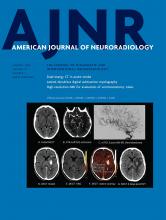Index by author
Baek, J.H.
- Head and Neck ImagingYou have accessCT and MRI Findings of Glomangiopericytoma in the Head and Neck: Case Series Study and Systematic ReviewC.H. Suh, J.H. Lee, M.K. Lee, S.J. Cho, S.R. Chung, Y.J. Choi and J.H. BaekAmerican Journal of Neuroradiology January 2020, 41 (1) 155-159; DOI: https://doi.org/10.3174/ajnr.A6336
Balchandani, P.
- Adult BrainOpen AccessEmerging Use of Ultra-High-Field 7T MRI in the Study of Intracranial Vascularity: State of the Field and Future DirectionsJ.W. Rutland, B.N. Delman, C.M. Gill, C. Zhu, R.K. Shrivastava and P. BalchandaniAmerican Journal of Neuroradiology January 2020, 41 (1) 2-9; DOI: https://doi.org/10.3174/ajnr.A6344
Banerjee, M.
- FELLOWS' JOURNAL CLUBAdult BrainOpen AccessVessel Wall Thickening and Enhancement in High-Resolution Intracranial Vessel Wall Imaging: A Predictor of Future Ischemic Events in Moyamoya DiseaseA. Kathuveetil, P.N. Sylaja, S. Senthilvelan, K. Chandrasekharan, M. Banerjee and B. Jayanand SudhirAmerican Journal of Neuroradiology January 2020, 41 (1) 100-105; DOI: https://doi.org/10.3174/ajnr.A6360
Twenty-nine patients with Moyamoya disease were enrolled in this study. The median age at symptom onset was 12 years. A total of 166 steno-occlusive lesions were detected by high-resolution intracranial vessel wall imaging. Eleven lesions with concentric wall thickening (6.6%) were noted in 9 patients. Ten concentric contrast-enhancing lesions were observed in 8 patients, of which 4 lesions in 3 patients showed grade II enhancement. The presence of contrast enhancement and wall thickening showed a statistically significant association with ischemic events within 3 months before and after the vessel wall imaging. The presence of wall thickening and enhancement may predict future ischemic events in patients with MMD.
Bartha-doering, L.
- FunctionalYou have accessLesion-Specific Language Network Alterations in Temporal Lobe EpilepsyO. Foesleitner, K.-H. Nenning, L. Bartha-Doering, C. Baumgartner, E. Pataraia, D. Moser, M. Schwarz, V. Schmidbauer, J.A. Hainfellner, T. Czech, C. Dorfer, G. Langs, D. Prayer, S. Bonelli and G. KasprianAmerican Journal of Neuroradiology January 2020, 41 (1) 147-154; DOI: https://doi.org/10.3174/ajnr.A6350
Baumgartner, C.
- FunctionalYou have accessLesion-Specific Language Network Alterations in Temporal Lobe EpilepsyO. Foesleitner, K.-H. Nenning, L. Bartha-Doering, C. Baumgartner, E. Pataraia, D. Moser, M. Schwarz, V. Schmidbauer, J.A. Hainfellner, T. Czech, C. Dorfer, G. Langs, D. Prayer, S. Bonelli and G. KasprianAmerican Journal of Neuroradiology January 2020, 41 (1) 147-154; DOI: https://doi.org/10.3174/ajnr.A6350
Bay, C.
- FELLOWS' JOURNAL CLUBAdult BrainOpen AccessDeep Transfer Learning and Radiomics Feature Prediction of Survival of Patients with High-Grade GliomasW. Han, L. Qin, C. Bay, X. Chen, K.-H. Yu, N. Miskin, A. Li, X. Xu and G. YoungAmerican Journal of Neuroradiology January 2020, 41 (1) 40-48; DOI: https://doi.org/10.3174/ajnr.A6365
Fifty patients with high-grade gliomas from the authors’ hospital and 128 patients with high-grade gliomas from The Cancer Genome Atlas were included in this study. For each patient, the authors calculated 348 hand-crafted radiomics features and 8192 deep features generated by a pretrained convolutional neural network. They then applied feature selection and Elastic Net-Cox modeling to differentiate patients into long- and short-term survivors. In the 50 patients with high-grade gliomas from their institution, the combined feature analysis framework classified the patients into long- and short-term survivor groups with a log-rank test P value <.001. In the 128 patients from The Cancer Genome Atlas, the framework classified patients into long- and short-term survivors with a log-rank test P value of .014. In conclusion, the authors report successful production and initial validation of a deep transfer learning model combining radiomics and deep features to predict overall survival of patients with glioblastoma from postcontrast T1-weighed brain MR imaging.
Beall, D.
- EDITOR'S CHOICESpine Imaging and Spine Image-Guided InterventionsYou have accessNumber Needed to Treat with Vertebral Augmentation to Save a LifeJ.A. Hirsch, R.V. Chandra, N.S. Carter, D. Beall, M. Frohbergh and K. OngAmerican Journal of Neuroradiology January 2020, 41 (1) 178-182; DOI: https://doi.org/10.3174/ajnr.A6367
The purpose of this study was to calculate the number needed to treat to save 1 life at 1 year and up to 5 years after vertebral augmentation. A 10-year sample of the 100% US Medicare data base was used to identify patients with vertebral compression fractures treated with nonsurgical management, balloon kyphoplasty, and vertebroplasty. The number needed to treat was calculated between augmentation and nonsurgical management groups from years 1–5 following a vertebral compression fracture diagnosis, using survival probabilities for each management approach. The adjusted number needed to treat to save 1 life for nonsurgical management versus kyphoplasty ranged from 14.8 at year 1 to 11.9 at year 5. The adjusted number needed to treat for nonsurgical management versus vertebroplasty ranged from 22.8 at year 1 to 23.8 at year 5. The authors conclude that the NNT analysis of more than 2 million patients with VCF reveals that only 15 patients need to be treated to save 1 life at 1 year. This has an obvious clinically significant impact and given that all augmentation clinical trials are underpowered to detect a mortality benefit, this large dataset analysis reveals that vertebral augmentation provides a significant mortality benefit over nonsurgical management with a low NNT.
Beheshtian, E.
- You have accessRedundant Neurovascular Imaging: Who Is to Blame and What Is the Value?E. Beheshtian, S. Emamzadehfard, S. Sahraian, R. Jalilianhasanpour and D.M. YousemAmerican Journal of Neuroradiology January 2020, 41 (1) 35-39; DOI: https://doi.org/10.3174/ajnr.A6329
Benson, J.C
- Spine Imaging and Spine Image-Guided InterventionsOpen AccessLateral Decubitus Digital Subtraction Myelography: Tips, Tricks, and PitfallsD.K. Kim, W. Brinjikji, P.P. Morris, F.E. Diehn, V.T. Lehman, G.B. Liebo, J.M. Morris, J.T. Verdoorn, J.K. Cutsforth-Gregory, R.I. Farb, J.C Benson and C.M. CarrAmerican Journal of Neuroradiology January 2020, 41 (1) 21-28; DOI: https://doi.org/10.3174/ajnr.A6368
Berndt, M.T.
- Adult BrainYou have accessMicrostructural Integrity of Salvaged Penumbra after Mechanical ThrombectomyM.T. Berndt, C. Maegerlein, T. Boeckh-Behrens, S. Wunderlich, C. Zimmer, S. Wirth, F.G. Mück, S. Mönch, B. Friedrich and J. KaesmacherAmerican Journal of Neuroradiology January 2020, 41 (1) 79-85; DOI: https://doi.org/10.3174/ajnr.A6364








